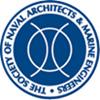Towing Tank Model Tests for Propulsive Performance Analysis of a Waterjet-Propelled Amphibious Vehicle
IF 1
4区 工程技术
Q3 ENGINEERING, CIVIL
引用次数: 4
Abstract
The present study aims to examine the resistance and propulsion performance of an amphibious vehicle with waterjet propulsion by conducting a series of towing tank model tests. The test model was an armored vehicle consisted of a box-shaped chassis, two flush-type waterjets, a bow flap, and a trimtab. Following the powering prediction procedure of a conventional ship, the resistance test, waterjet system and bollard pull test, and self-propulsion test were performed. The Froude number based on the characteristic length and advance speed for the model test ranged from 0.883 to 1.275. The effect of the track deployment conditions was also investigated by conducting a test with the retracted and normal track condition. In the bollard pull and self-propulsion test where two waterjets were installed onto the chassis, the flow rate of the waterjet was higher than that in the single waterjet system test, resulting in high thrust. The propulsive efficiency increased in high advance speeds as the transom was exposed to air.水陆两栖车辆推进性能分析拖曳舱模型试验
本研究旨在通过一系列拖曳水箱模型试验,研究水陆两栖车辆的阻力和推进性能。试验模型是一辆装甲车辆,由一个箱形底盘,两个冲洗型水射流,一个艏襟翼和一个修剪板组成。按照常规船舶动力预测程序,进行了阻力试验、水射流系统及系柱拉力试验和自推进试验。模型试验基于特征长度和推进速度的弗劳德数取值范围为0.883 ~ 1.275。同时,通过收回轨道和正常轨道的试验,研究了轨道展开条件的影响。在系柱拉拔和自推进试验中,在底盘上安装了两个水射流系统,水射流的流量比单水射流系统试验时要大,产生了较大的推力。在高推进速度下,由于尾梁暴露在空气中,推进效率提高了。
本文章由计算机程序翻译,如有差异,请以英文原文为准。
求助全文
约1分钟内获得全文
求助全文
来源期刊

Journal of Ship Research
工程技术-工程:海洋
CiteScore
2.80
自引率
0.00%
发文量
12
审稿时长
6 months
期刊介绍:
Original and Timely technical papers addressing problems of shipyard techniques and production of merchant and naval ships appear in this quarterly publication. Since its inception, the Journal of Ship Production and Design (formerly the Journal of Ship Production) has been a forum for peer-reviewed, professionally edited papers from academic and industry sources. As such, it has influenced the worldwide development of ship production engineering as a fully qualified professional discipline. The expanded scope seeks papers in additional areas, specifically ship design, including design for production, plus other marine technology topics, such as ship operations, shipping economic, and safety. Each issue contains a well-rounded selection of technical papers relevant to marine professionals.
 求助内容:
求助内容: 应助结果提醒方式:
应助结果提醒方式:


